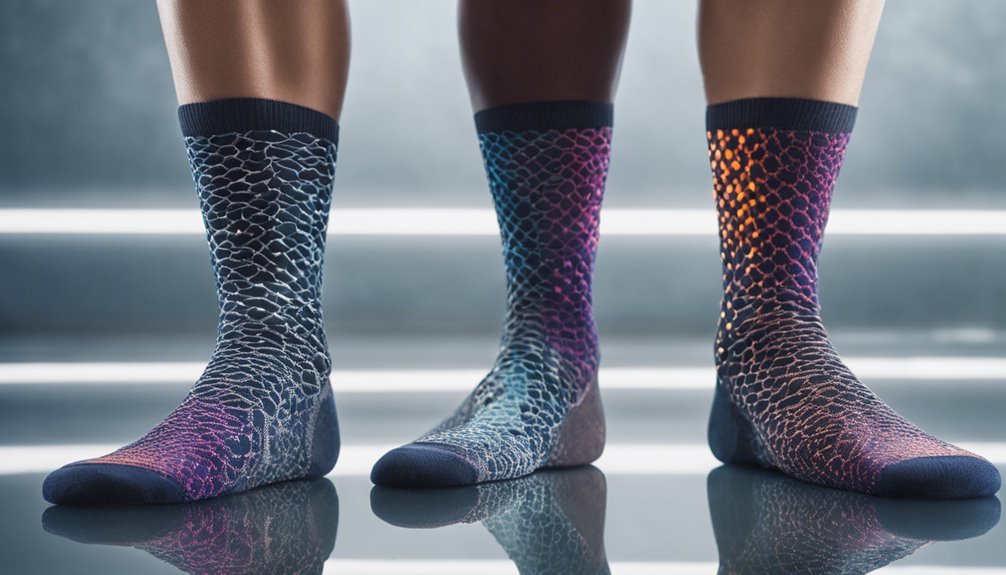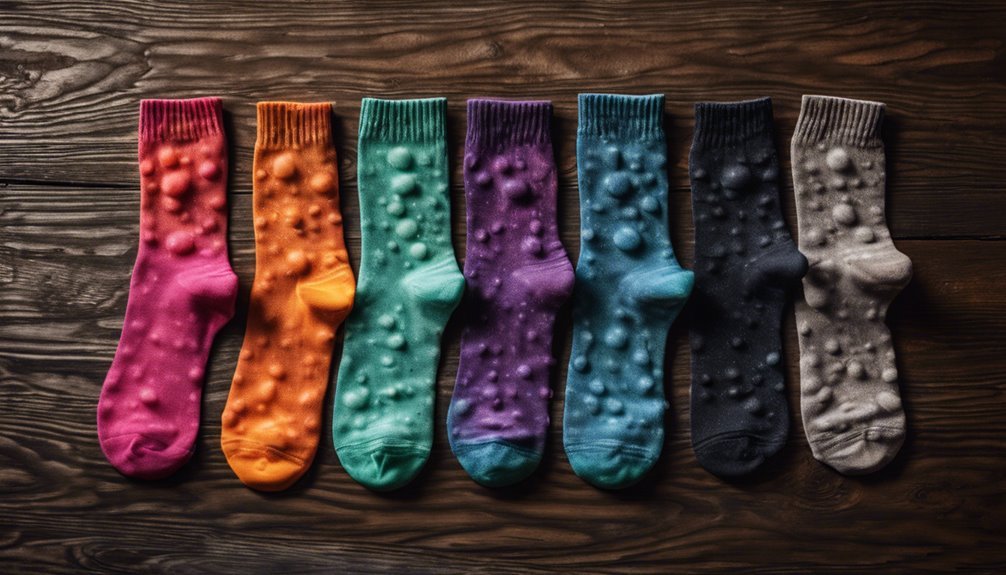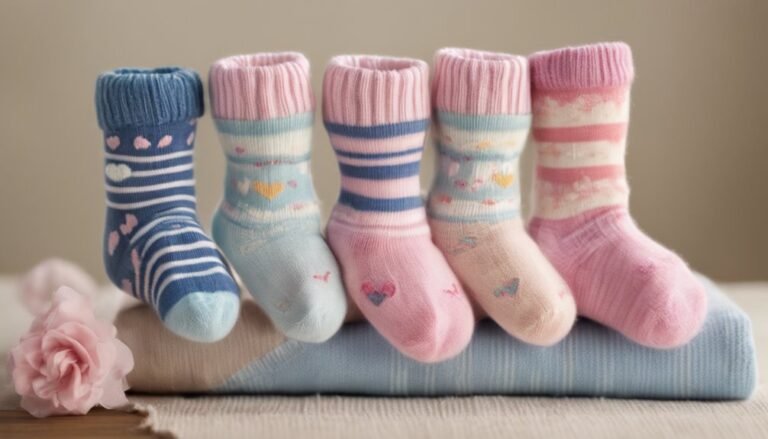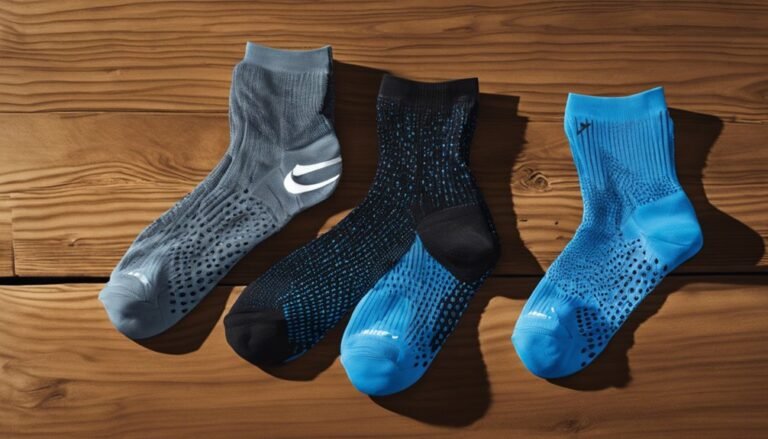Moisture-Wicking Socks vs. Sweat-Absorbing Socks: Which Works Best?
When choosing between moisture-wicking and sweat-absorbing socks, it really comes down to your activity level. Moisture-wicking socks actively draw sweat away from your skin, making them ideal for vigorous activities like running or hiking. On the other hand, sweat-absorbing socks retain moisture, which can be more comfortable for low-intensity workouts or casual wear. Selecting the right sock can enhance your performance and comfort, plus there's more to discover about materials and maintenance for your perfect fit.
Understanding Moisture-Wicking Technology

When it comes to staying comfortable during physical activities, understanding moisture-wicking technology is essential. This fabric technology is designed to enhance moisture management by drawing sweat away from your skin and allowing it to evaporate quickly. Unlike traditional fabrics, moisture-wicking materials, such as polyester or nylon blends, create a barrier that keeps your feet dry and reduces the risk of blisters and discomfort. When you're engaged in activities like running or hiking, these advanced fabrics guarantee your socks work with your body's natural cooling mechanism. By choosing moisture-wicking socks, you're not just investing in comfort; you're also empowering yourself to move freely, knowing your gear is actively supporting your performance. This technology truly transforms the experience of staying active.
The Science Behind Sweat-Absorbing Socks
Moisture-wicking technology offers a clear advantage for active individuals, but sweat-absorbing socks provide a different approach to foot comfort. These socks are crafted from specialized sock materials designed to absorb moisture rather than repel it. Utilizing natural fibers like cotton or bamboo, they excel in sweat absorption, trapping moisture away from your skin. This helps prevent the discomfort associated with damp socks, promoting a more pleasant experience during wear. The fibers can hold a significant amount of moisture, allowing your feet to breathe while still remaining dry. However, while they manage sweat effectively, it's important to remember that they may not dry as quickly as moisture-wicking options, potentially leading to a soggy feeling during intense activities.
Key Differences Between Moisture-Wicking and Sweat-Absorbing Socks
While both moisture-wicking and sweat-absorbing socks aim to enhance foot comfort, they achieve this through fundamentally different mechanisms. Moisture-wicking socks utilize specialized synthetic fibers that pull moisture away from your skin, promoting evaporation and keeping your feet dry. This is a key aspect of effective moisture management, especially during vigorous activities. In contrast, sweat-absorbing socks are typically made from natural materials like cotton, which soak up moisture but can leave your feet damp. In a socks comparison, you'll find that moisture-wicking options are often preferred for active use, while sweat-absorbing socks may be more comfortable for casual wear. Choosing between them largely depends on your activity level and personal comfort preferences.
Benefits of Moisture-Wicking Socks

For those who engage in sports or spend extended periods on their feet, moisture-wicking socks provide significant advantages. These specialized socks actively draw moisture away from your skin, keeping your feet dry and comfortable. This not only enhances your performance but also contributes to better foot health by reducing the risk of blisters and fungal infections. When your feet stay dry, you maintain ideal temperature regulation, which is essential during intense activities. Additionally, moisture-wicking materials often have antimicrobial properties, further protecting your feet from odor and bacteria. By choosing moisture-wicking socks, you're investing in your comfort and well-being, allowing you to focus on your activities without the distraction of damp, uncomfortable feet.
Advantages of Sweat-Absorbing Socks
When it comes to managing sweat during physical activities, sweat-absorbing socks have their own set of distinct advantages. One of the primary sweat absorption benefits is their ability to effectively capture moisture, keeping your feet dry and comfortable, especially during prolonged activities. These socks are often made from materials like cotton or wool, which excel in moisture retention advantages, allowing them to hold sweat without feeling soggy. This can help prevent blisters and irritation, enhancing your overall performance. Additionally, sweat-absorbing socks can provide a cozy feel, making them ideal for leisurely activities or everyday wear. If you're looking for comfort and moisture management in your footwear, sweat-absorbing socks might just be the perfect fit for you.
Best Activities for Moisture-Wicking Socks
If you're looking to enhance your performance in high-intensity activities, moisture-wicking socks are an excellent choice. These socks excel during running marathons, where prolonged exertion can lead to excessive sweating. For hiking trails and outdoor adventures, they keep your feet dry and comfortable, preventing blisters. In gym workouts and CrossFit training, the breathability helps maintain focus by reducing discomfort. During cycling sessions, they manage moisture, allowing for better pedal efficiency. Whether you're playing basketball games or participating in team sports, moisture-wicking socks provide the support you need. They're also ideal for yoga classes and skiing trips, ensuring you stay dry and agile. Choose moisture-wicking socks to maximize your performance and enjoy your activities to the fullest.
Ideal Scenarios for Sweat-Absorbing Socks

When temperatures drop, sweat-absorbing socks can be your best ally for comfort during cool weather activities. They're also ideal for low-intensity workouts, where moisture management isn't as critical. Additionally, if you're just going about your daily routine, these socks provide a cozy option that keeps your feet feeling dry without the need for heavy-duty moisture-wicking technology.
Cool Weather Activities
Although moisture-wicking socks are often highlighted for their performance in warmer conditions, sweat-absorbing socks can be particularly beneficial during cool weather activities. When you're engaging in winter sports like skiing or snowboarding, you'll appreciate how these socks manage moisture. They absorb sweat, preventing that cold, clammy feeling that can distract you from enjoying your time outdoors.
In cooler temperatures, maintaining warmth is essential, and sweat-absorbing socks help by creating a barrier against the chill. Their thicker material provides insulation, keeping your feet cozy while also managing moisture effectively. For those long days on the slopes or brisk hikes, choosing sweat-absorbing socks guarantees comfort and performance, allowing you to focus on the freedom of the great outdoors.
Low-Intensity Workouts
For those engaging in low-intensity workouts, sweat-absorbing socks are an excellent choice to enhance comfort and performance. Whether you're doing yoga, leisurely walks, or other low-impact exercises, these socks can effectively manage moisture, keeping your feet dry and comfortable. Unlike moisture-wicking socks, which are designed for high perspiration levels, sweat-absorbing socks excel in scenarios where sweat production is minimal. Their plush fabric allows for improved sock comfort, reducing friction and the risk of blisters during gentle movement. Additionally, they provide a soft feel against your skin, allowing you to focus on your workout without distraction. Ultimately, choosing the right sock can greatly elevate your experience during low-intensity activities, letting you enjoy freedom in every step.
Casual Daily Wear
While choosing socks for casual daily wear, opting for sweat-absorbing socks can greatly enhance your comfort throughout the day. These socks are designed to pull moisture away from your skin, keeping your feet dry and fresh, which is essential for casual comfort. Here are some ideal scenarios for wearing them:
- Long days at the office where you're on your feet.
- Weekend outings where you might be walking or standing for extended periods.
- Casual social gatherings where comfort is key.
- Running errands in varying weather conditions.
Choosing the Right Material for Your Socks
Choosing the right material for your socks can greatly impact your comfort and performance during various activities. When selecting sock materials, consider fabric types that suit your needs. For moisture-wicking, synthetic fibers like polyester or nylon effectively pull sweat away from your skin, keeping your feet dry. Merino wool is an excellent choice for temperature regulation and odor resistance, making it ideal for both active and casual wear. If you prefer a more traditional option, cotton offers softness but isn't as effective at moisture management. Each fabric type has its pros and cons, so weigh your priorities—whether it's breathability, durability, or insulation. By understanding sock materials, you can make informed choices that enhance your freedom and enjoyment during every activity.
Tips for Maintaining Your Socks
To keep your socks in ideal condition, it is crucial to follow proper washing techniques, drying recommendations, and storage best practices. Start by checking the care label for specific washing instructions and avoid using harsh detergents. Once washed, let them air dry to maintain their moisture-wicking properties, and store them in a cool, dry place to prevent damage.
Proper Washing Techniques
When it comes to maintaining the performance and longevity of your socks, proper washing techniques are essential. Here are some practical insights to guarantee your socks stay in top shape:
- Use cold water: Hot water can damage the fibers and reduce moisture-wicking capabilities.
- Gentle detergent: Choose a mild detergent that won't strip away the socks' technical features.
- Avoid fabric softeners: They can leave residues that hinder moisture-wicking efficiency.
- Wash inside out: This helps protect the outer layer and keeps the socks functioning effectively.
Drying Recommendations
Although you might be tempted to toss your socks in the dryer, opting for air drying is often the best choice to preserve their moisture-wicking capabilities. High heat from dryers can break down the fibers, reducing their effectiveness over time. Instead, consider using effective drying techniques like laying them flat on a clean towel or hanging them up in a well-ventilated space. If you're in a hurry, you can use a fan or a clothesline to expedite the process without exposing your socks to harsh conditions. Remember, proper sock care extends their lifespan and keeps them performing at their best. By following these simple drying recommendations, you'll guarantee your moisture-wicking socks stay fresh and functional for many adventures to come.
Storage Best Practices
Once your moisture-wicking socks are clean and dry, proper storage is key to maintaining their performance. By following a few simple sock organization tips, you'll guarantee they stay in top shape for your next adventure. Consider using storage containers that are breathable to avoid moisture buildup. Here are some best practices:
- Keep them paired: Always store socks together to prevent mismatches.
- Avoid folding: Instead, roll them to maintain elasticity.
- Use labeled bins: This makes it easier to find specific types when you need them.
- Store in a cool, dry place: Excess heat or humidity can degrade fabric performance.
Making the Right Choice for Your Lifestyle
How do you choose the right socks for your lifestyle? Start by evaluating your daily activities. If you're active—running, hiking, or participating in sports—opt for moisture-wicking socks. They'll keep your feet dry and comfortable, preventing blisters and odors. On the other hand, if you spend most of your time indoors or in cooler environments, sweat-absorbing socks may be more suitable for your needs.
Consider sock selection tips like the material and fit; synthetic fabrics often outperform cotton in moisture management. Ultimately, assess your lifestyle compatibility to guarantee your sock choice aligns with your routines. Remember, the right socks can enhance your comfort and freedom, so choose wisely based on your unique activities and preferences.
Frequently Asked Questions
Can Moisture-Wicking Socks Prevent Blisters During Intense Workouts?
Imagine running a marathon in sandals—painful, right? To prevent blisters during intense workouts, moisture-wicking sock materials efficiently manage sweat, reducing friction. Choose wisely; your feet deserve the best protection and comfort for freedom in movement.
How Often Should I Replace My Moisture-Wicking or Sweat-Absorbing Socks?
You should replace your socks every 6 to 12 months, depending on usage. Regular sock maintenance, like washing them properly, can extend their lifespan, but worn-out socks might compromise comfort and performance during activities.
Are Moisture-Wicking Socks Suitable for Everyday Wear?
When it comes to everyday wear, moisture-wicking socks can really be a game changer. They offer exceptional everyday comfort due to their fabric choice, keeping your feet dry and fresh, no matter the activity.
Do Sweat-Absorbing Socks Retain Odors Over Time?
Yes, sweat-absorbing socks can retain odors over time due to odor retention from bacteria. To maintain sock hygiene, wash them regularly, and consider using breathable materials to minimize odor issues, ensuring your comfort and freedom.
Can I Wash Moisture-Wicking Socks With Fabric Softener?
Washing moisture-wicking socks with fabric softener might seem tempting, but it can compromise their effectiveness. Stick to washing guidelines that exclude fabric softener to maintain their moisture-wicking properties and guarantee your comfort during activities.







